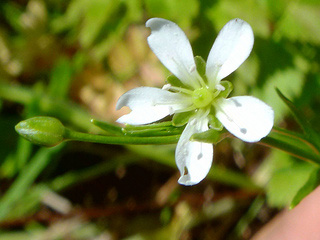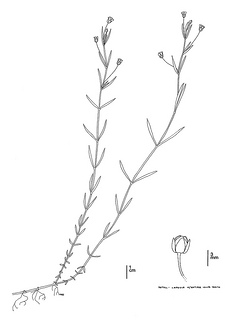(Arenaria paludicola)
 Arenaria paludicola. CDFW Photo by Krystal Acierto.
Arenaria paludicola. CDFW Photo by Krystal Acierto.
 Arenaria paludicola. CDFW illustration by Mary Ann Showers. (Click to enlarge)
Arenaria paludicola. CDFW illustration by Mary Ann Showers. (Click to enlarge)
Marsh sandwort is a California endangered plant species, which means that killing or possessing the plant is prohibited by the California Endangered Species Act (CESA). Marsh sandwort is also listed as endangered under the federal Endangered Species Act. Marsh sandwort has been found in widely disjunct populations north to Washington and south to Southern California, but its range may also extend into Mexico. Marsh sandwort is known to occur in marshes, swamps and areas that are wet year-round. Although relatively little is known about the habitat conditions where marsh sandwort was historically found, there are reports of it growing up through dense mats of reeds, cattails, rushes, and bulrushes. Only one naturally-occurring population of marsh sandwort is known to remain in California. This natural population is at Oso Flaco Lake in San Luis Obispo County. Marsh sandwort has also been introduced to sites at Sweet Springs Marsh at Morro Bay, the Guadalupe-Nipomo Dunes National Wildlife Refuge in southern San Luis Obispo County, at Wilder Ranch/Baldwin Creek in Santa Cruz County, and in the Marin Headlands portion of the Golden Gate National Recreation Area in Marin County. Plantings have been unsuccessful at some of these introduction sites.
Threats to marsh sandwort are all related to alteration and destruction of coastal freshwater habitats. These threats are caused by development, urbanization, loss of groundwater, competition with other species, the addition of excess nutrients and sediment to habitat, and due to the vulnerability of small and localized plant populations to extirpation.
A Spotlight Species Action Plan was prepared for marsh sandwort by the U.S. Fish and Wildlife Service in 2009 that includes several recommended actions to prevent the extinction of the species. Short term recommendations of the plan include producing and maintaining plants and seeds in botanic gardens for reintroductions, reducing competing plant species, investigating water quality threats, and planting new marsh sandwort populations in the wild. Longer term recommendations include investigating the nutrient levels in historical habitat and proposed reintroduction sites, determining the nutrient levels in the watershed with the remaining naturally-occurring population, removing water quality threats using a bioswale system, and performing other site-specific management activities.
CDFW may issue permits for marsh sandwort pursuant to CESA, and you can learn more about the California laws protecting marsh sandwort and other California native plants. Populations of marsh sandwort occur in CDFW’s Central Region. More information is also available from the U.S. Fish and Wildlife Service Species Profile for Marsh Sandwort.
Updated 06/18/2013